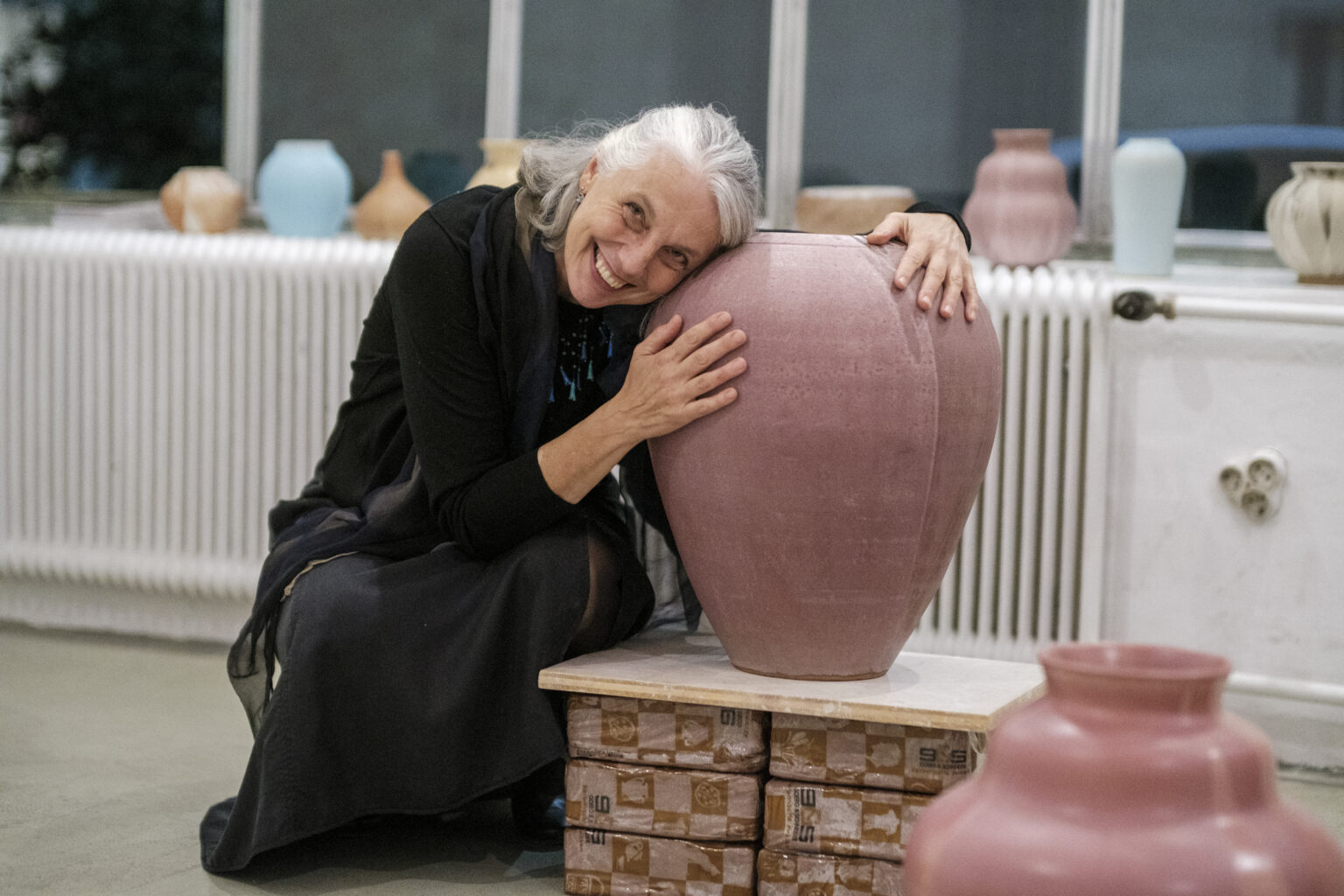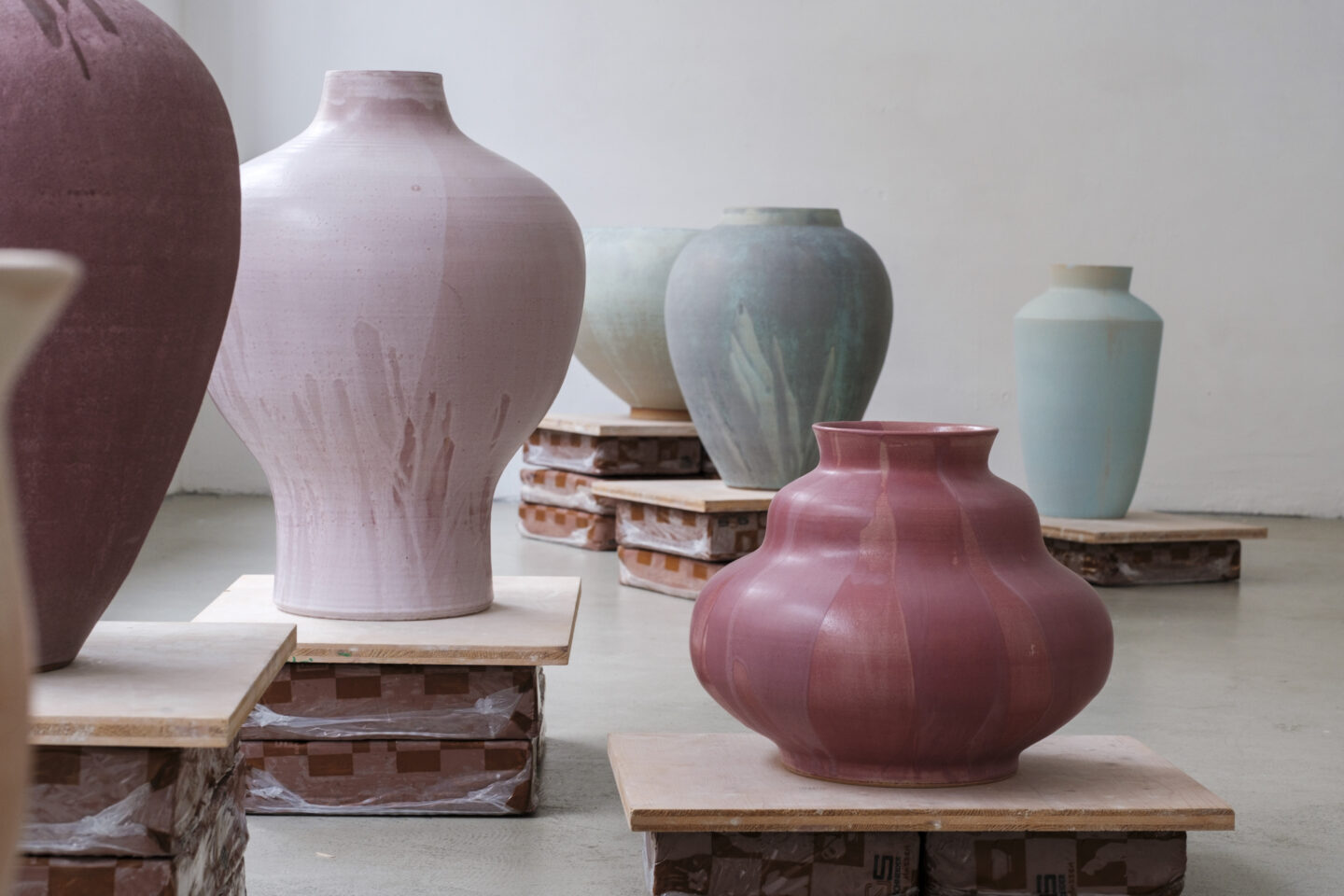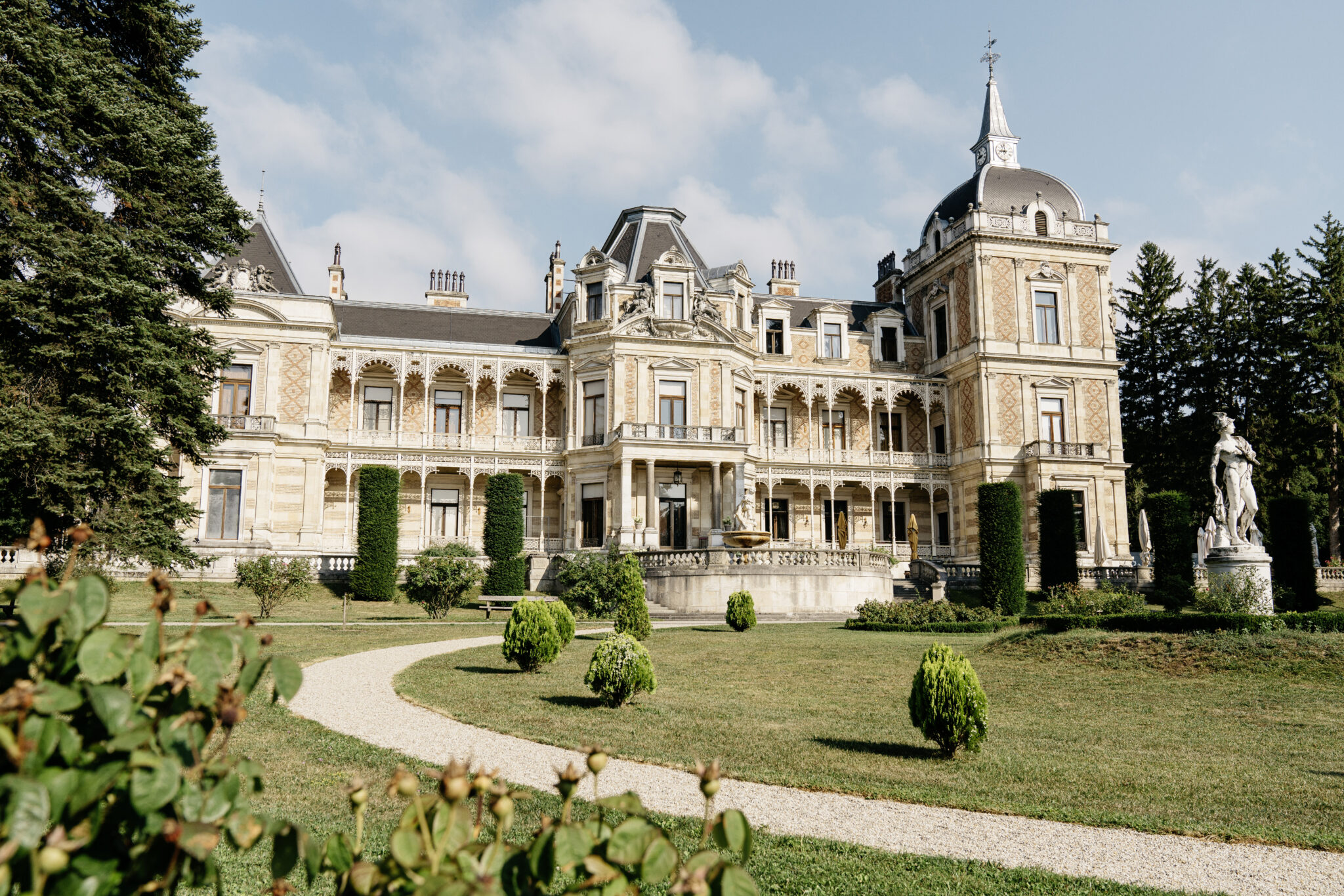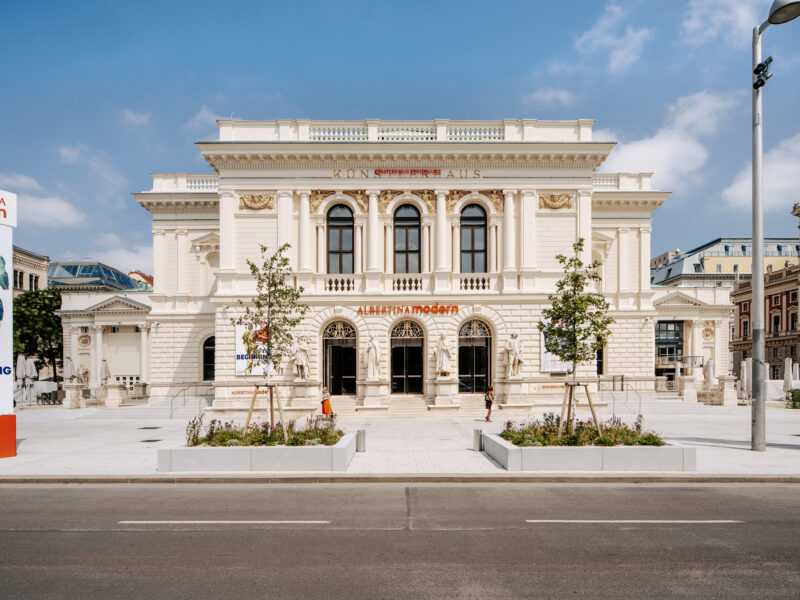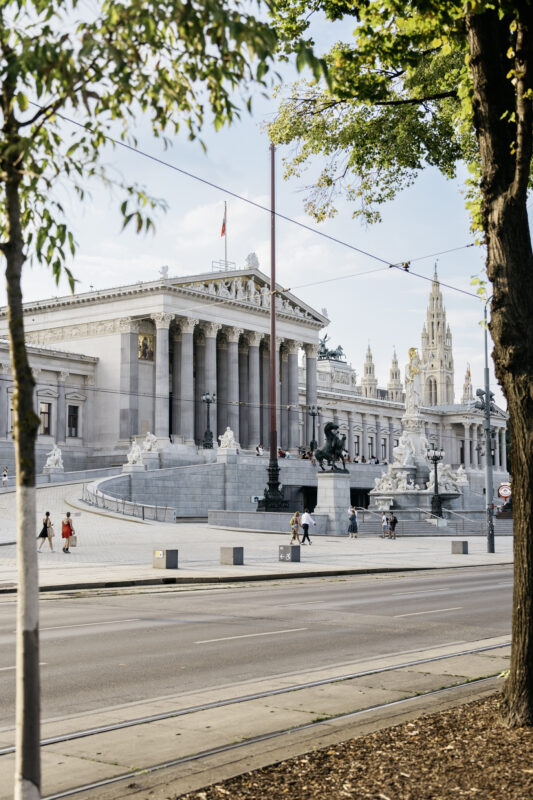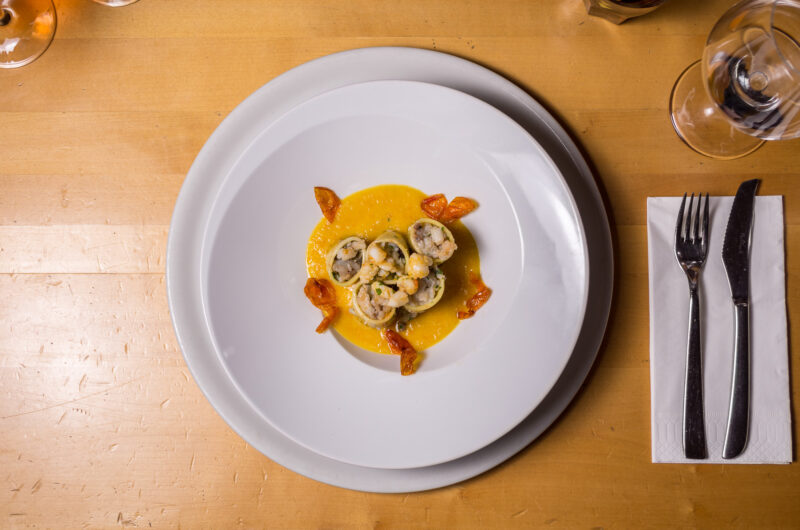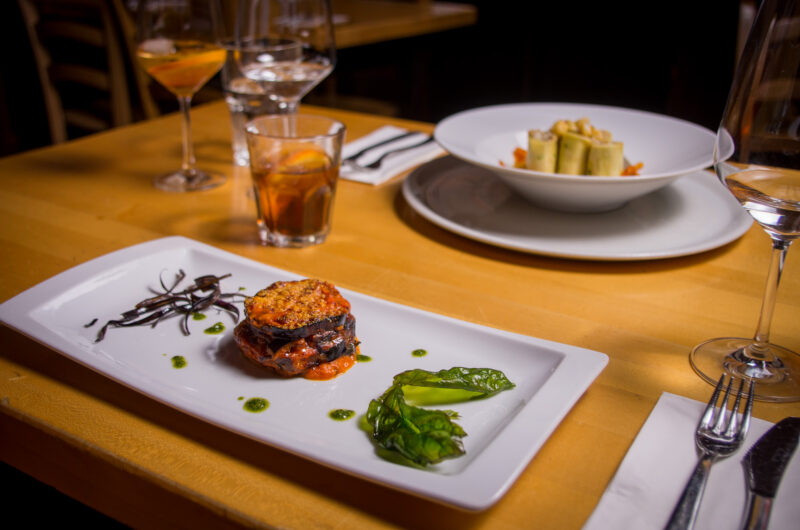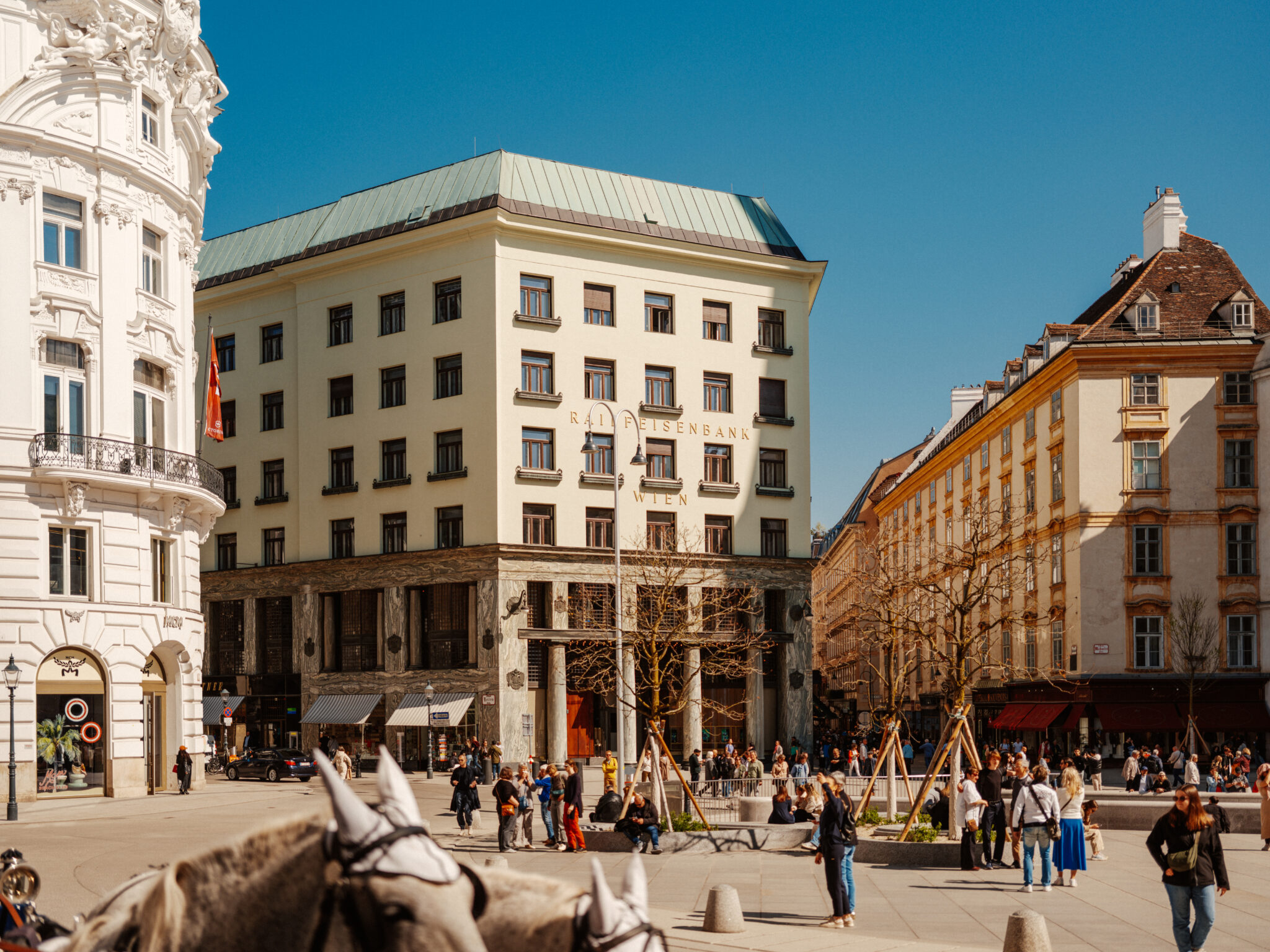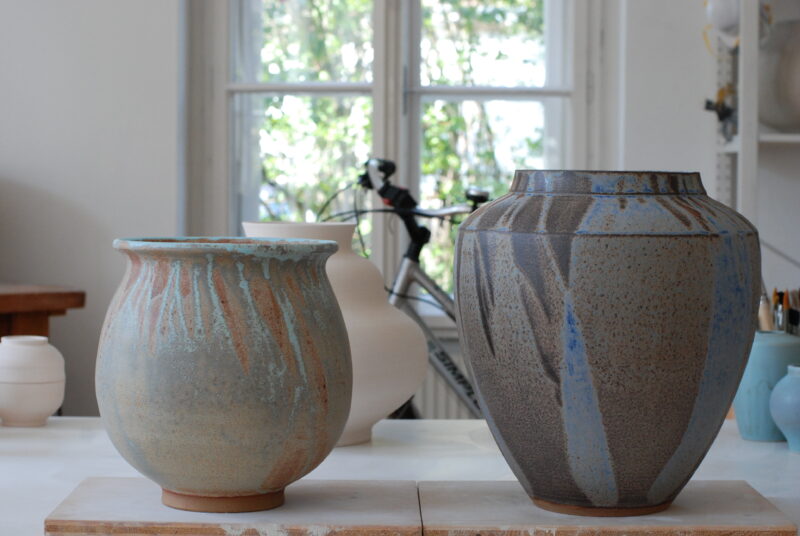After the birth of her daughter and son in the late 1990s, Melanie van der Donk decided to quit her career in theatre. Instead, she set up an art workshop for children, but the desire to become a ceramicist remained in her mind. Finally, she enrolled in a ceramics course at the University of Applied Arts in Vienna.
Encouraged and inspired by her teachers Marion Lorenz and Anton Andert, van der Donk ultimately decided to earn her living with ceramics and to develop her own design language. Bulbous forms in pastel shades and layers of glazes characterise her ceramics. For about 10 years, she has also been passing on her knowledge to others at the Vienna Adult Education Center.
© Courtesy of the artist
Which place do you currently call home and where do you work on your projects?
I live and work in Vienna’s 13th district. It’s a fairly conservative area, but one that also offers close contact with nature. Meadows with sweeping views over the city are never far away, and the Lainzer Tiergarten lies right on the doorstep. Once the imperial hunting grounds, it is home to the Hermesvilla, built in the 19th century for Empress Sissi. The Schönbrunn Palace Park, with its famous zoo, is also located here.
Across in the 14th district, the Vienna Woods can be reached quickly—perfect for long walks. From higher points such as the Sophienalpe, you can enjoy breathtaking views. Further north, around Nussdorf, Grinzing, and Cobenzl, the vineyards stretch across the hills, a unique feature of Vienna: viticulture within the city itself. You’ll even find vines on the other side of the Danube, in Stammersdorf and Bisamberg.
© WienTourismus/ Gregor Hofbauer
Do you have a favourite place in your area where you like to relax and linger?
To relax, I often take my dog Gustaf for walks through the meadows or the forest. One of the things I love about Vienna is how quickly you can step outdoors and into nature. I also enjoy unwinding in one of the city’s historic baths with saunas and steam rooms, like the Amalienbad—built in the 1920s with tiles by the Schwadron brothers—or the Jörgerbad, opened in 1914 and famous for its striking glass roof. For a more modern experience, the Therme Oberlaa offers expansive outdoor areas and spa facilities.
In summer, swimming in the Old Danube is a favorite pastime. I especially like the Bundesbad Alte Donau, easily reached by underground, with its charming 1950s pavilion and shady trees. At the end of the day, bathers are gently asked to leave the river to the sound of Enrico Toselli’s Serenade op. 6,1, as swans glide in to reclaim the waters. In winter or on rainy days, nothing beats Vienna’s traditional coffee houses—I’m fond of Café Jelinek and Café Prückel. And sometimes, I find relaxation in Vienna’s museums, where I feel surrounded by kindred spirits.
Are there any urgent political issues or problems in your region?
Soil sealing is a major issue, especially in Austria. Corruption is also constantly in the news at the moment, so there is hope that more will be uncovered than in the past. Otherwise, we have the same issues as other European countries: a growing right-wing party, racism, questions surrounding migration, the climate crisis, data protection, inflation and the question of how to end these terrible wars or how to help.
In your opinion, what has developed well in the last 5 years—and what has not?
Vienna has expanded its cycle paths, and there are plenty of rental bikes and bike stations, though there is still room for improvement. The city is also taking measures to stay cool in summer, installing many public drinking fountains—Vienna is known for its high-quality spring water. The “Parkpickerl” has been introduced in all districts to reduce traffic, favor public transport, and manage parking: locals can park in their district without time limits, while visitors can only park for a limited time and usually have to pay at a meter.
It’s a pity that many small specialty shops, once so typical of Vienna, are disappearing. The same goes for restaurants, as many traditional establishments are replaced by trendy bars and eateries that all look and feel similar.
Property prices have risen rapidly. Although the city of Vienna offers a lot of social housing, it has definitely become more difficult to rent or buy a private flat.
© WienTourismus/ Paul Bauer
© WienTourismus/ Gregor Hofbauer
Do you know a hidden gem when it comes to local manufacturers—whether it’s arts and crafts, sustainable products or food?
I like Viktoriya Sitochina‘s hat salon on Josefstädter Straße. It’s a truly extraordinary shop and definitely worth a visit if you’re looking for headwear.
I think Karak tiles are sensational. There is a showroom called ‘Formdepot’ in the 16th district, which sells handmade raku tiles. Friends recommend the Gragger&Cie bakery.
Is there anything particularly innovative in your region? Also in comparison to other places you have already visited?
Vienna’s public transport system is excellent, with an annual pass costing just €1 per day. There is also a climate ticket available for approximately € 1000, which allows unlimited use of all public transport throughout Austria for a year.
MA 48, the municipal waste collection service, works efficiently and even runs the so-called 48er Tandler, where you can buy almost anything you need at a reasonable price. They also compost organic waste, and the resulting soil can be picked up for free. The city’s parks department is very dedicated, and tulips and daffodils sometimes bloom on the green strips along the roads.
Vienna also supports fantastic markets, such as the Brunnenmarkt, Karmelitermarkt, and many others. Unfortunately, the Naschmarkt has become more of a tourist spot and snack bar. The city also encourages neighbourhood and community gardens, which are becoming increasingly common.
Due to concerns about bee mortality, beehives have even been installed on buildings in the city centre, such as the KHM, and the honey produced is available for purchase.
Do you have a secret restaurant tip that you would like to share with us?
Vienna offers excellent dining overall, but personally, I prefer restaurants in beautiful locations where the atmosphere is just as important as the food. In summer, I love Piaristenplatz in the 8th district, where you can enjoy pizza at Il Sestante, sitting in the charming Italian-style setting of the baroque Roman Catholic church, convent, and grammar school. In the 1st district, Franziskanerplatz is home to Kleines Cafe, designed by Hermann Czech in the 1970s and owned by actor Hanno Pöschl, where good sandwiches pair perfectly with wine or beer. For hearty Bohemian cuisine in a cozy winter setting, Nordpol in the 20th district near the Augarten—with its baroque park and flag towers—is a favorite. Rüdiger Hof in Margareten, established in 1903, offers an Art Nouveau atmosphere, great beer, and a lovely outdoor dining area under old maple trees, although it has become quite trendy and busy. Less well-known but beautifully restored is Weinhaus Pfandler in Meidling.
If you are staying in Vienna during the beautiful season, there are countless charming wine taverns, such as the Haslinger wine tavern in Sievering. I also really like the Häuserl am Stoan on Höhenstraße, a traditional Viennese home-cooking restaurant with stunning summer views over the city. If you’re hungry in between meals or late at night, you’ll find what you’re looking for at the Viennese sausage stands, although there are still few vegan sausages. Last but not least, the city’s coffee house culture deserves a mention here, constantly evolving while staying true to tradition.
In May 2025, painter Roger Schindler opened his lovingly designed café “Alte Bäckerei” at Burggasse 29, near the Museumsquartier and the Volkstheater. It is a place for good conversation, reading, relaxing, but also for celebrating. Another highly Viennese establishment that I frequent is the Aida chain of patisseries. The pink-and-brown décor extends even to the waitresses’ uniforms and evokes the atmosphere of the 1950s. The coffee is excellent, and I usually enjoy a buttery croissant.
© Il Sestante
© Il Sestante
Is there a local shop whose products are only available in your region?
I’m not sure if this is unique to Vienna, but the city has so-called Zuckerlgeschäfte, candy shops unlike anywhere else. Beyond sweets, Vienna is full of specialty stores that feel like hidden treasures.
For example, Bottega Veloce is a paradise for lovers of vintage racing bikes, lovingly restored on site.
On Westbahnstraße, enthusiasts of old cameras will find exactly what they’re looking for, such as at Foto31. Neubers Enkel, a remarkable drugstore, offers almost all chemicals by the gram, bottles essential oils, and sells household products, with expertise spanning from shellac polish to cosmetics.
Baiers Enkel is perfect for goldsmiths and gemstone cutters, while sculptors can find everything they need at Weha on Lange Gasse.
I also love Walter Weiss on Mariahilfer Strasse, a beautiful shop offering stylish daily-care products—from shaving sets to brushes, soaps, and horn-made items by Petz—all accompanied by attentive service.
What are your 3 favourite apps that you use every day and couldn’t live without?
Unfortunately, I hardly ever use apps. But I like listening to Ö1, which is also available as an app. Friends recommend Ticket Gretchen, where you can get cheap tickets for cultural events, and Wien mobil.
Do you have any favourite newspapers or online magazines? And how do you keep up to date with politics or social and cultural issues?
Vienna is not spoiled with good press. Falter is the Viennese programme newspaper, in which you can find the entire cultural programme, including Lower Austria, on a weekly basis. It also has good articles on current political events. Furthermore, Der Standard is a readable daily newspaper. The homeless newspaper Augustin is available in pubs and underground stations. By purchasing it, you support the homeless and at the same time receive a lot of information and a section on free events in Vienna.
© WienTourismus/ Paul Bauer
Imagine you could be mayor for a year—what would you change?
First, I would abolish the free magazines ‘Heute’ and ‘Österreich’ or redesign them into a politically independent, well-founded, truly informative and understandable free newspaper for all citizens. In this context, I would support all measures that promote greater integration and coexistence. I would also support an affordable annual pass for all museums in Vienna and, of course, free admission for all students.
The education system should be expanded, made more accessible, and actively promoted to foster greater independence among pupils and students, allowing new ideas to emerge. I would also redesign and rebuild more streets as so-called ‘meeting zones’ and plant significantly more trees, creating vibrant spaces for community interaction and creativity.
It would also be beneficial to implement further measures to eliminate vacant properties, which could potentially help homeless people, students, migrants, artists and others. I would create a park on the Kettenbrückengasse car park. The speed limit in the city should be reduced to 30 km/h and even more should be done to curb traffic…
One last question: If you could choose another place to live—regardless of financial or time constrains—which one would you choose?
It would be nice if Vienna were located by the sea and the wind blew strongly from time to time.
© Courtesy of the artist
© Courtesy of the artist
